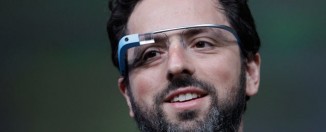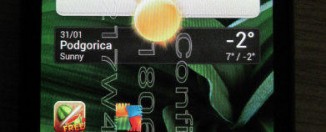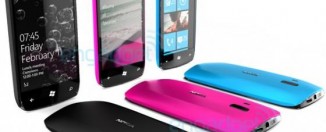From WAP to App – the top phones that defined the decade
The noughties was a decade of tremendous innovation for mobile phones that saw the total number of phones worldwide reach a staggering 3,973,453,793 (and counting).
Megapixels rose, gizmo upon gizmo was shoe-horned into phones that got ever thinner.
Today, as we start a new decade, it’s worth looking back to see how we got to where we are now. In the process, we’ll answer such burning questions as:
- which mobile phones were the icons of the Noughties?
- how did we get from featureless phones with tiny black and white screens to the technological marvels of the iPhone and the Droid?
- which mobile manufacturer saw its market share go from 21.1% to 4.5%?
- which was the single most important year for mobile phones in the entire decade and why?
- and what was the most successful mobile phone of the decade?
Read on and all will be revealed!
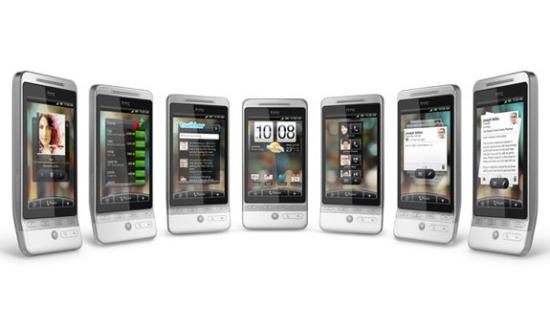
Contents
- 2000 – 2003: 3G, WAP and other turkeys
- 2004 – 2006: the rise of the feature phones
- 2007: the single most important year of the decade
- 2008 – 2009: the age of the touchscreen phones
- The shifting fortunes of the big 5 mobile manufacturers
- The top selling mobile phone of the decade
2000 – 2003: 3G, WAP and other turkeys
The start of the decade saw the advent of 3G, which promised unheard of mobile data speeds, video calls, mobile Web browsing, and all manner of futuristic technologies that seemed perfect for a new millennium.
The reality was, inevitably, a little different. Greedy Governments charged absurd prices for the right for the mobile operators to run 3G services. In total, 105 billion Euros was spent by the operators on 3G licences in Europe alone.
This huge amount of money meant there wasn’t an awful lot left for building the actual 3G networks! The result was a delayed roll out of 3G services, with poor coverage, slower than expected speeds, naff handsets and extremely expensive tariffs.
Not quite the revolution we were all expecting!
Still, it wasn’t all bad news – we still had WAP to keep us going (ho ho ho!)
WAP, i-Mode and other pants

Back in 2001, I was working for a games developer looking at new platforms on which to create games. Mobile phones were seen as one such platform, but the technology of the day was…well, limited!
The technology included WAP, which was basically a cut-down version of HTML designed specifically for mobile phones, and the Japanese alternative, i-Mode. Developing games for these technologies was like developing games for a calculator! It was pretty much text-only with excrutiatingly slow data rates and tiny screens. We soon gave up!
We also tried J2ME, a mobile version of Java. Although allowing much more interactivity than WAP and i-Mode, it was difficult to develop for simply because there was no consistent set of features across mobile phones.
At the time, mobile was meant to be the future, but the future was just that – a long way off!
The phones of the early 2000s
The world’s first camera phone
It’s hard to believe, but the world’s first camera phone only went on sale in 2001. Developed in 2000, the Sharp J-SH04 (below) was the world’s first commercial camera phone when it was released in Japan in 2001. The US had to wait another year for their first camera phone, the Sanyo 5300, which was released in November 2002.
The J-SH04 had just 110,000 pixels – that’s 0.1 megapixels, or 1/120 the size of today’s top-end camera phones such as the Sony Ericsson Satio.
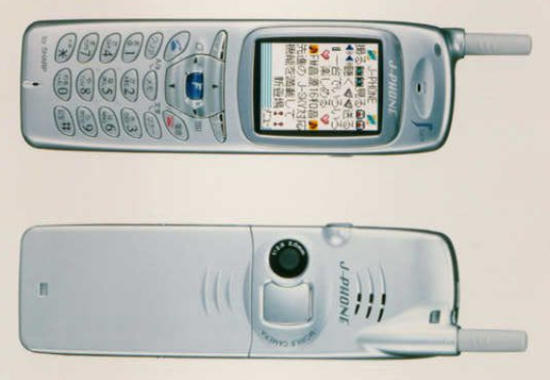
Not exactly smart phones
After attending a Motorola Developer’s Conference in 2002, I was given a brand new Motorola Accompli smartphone (below). At the time, I was in love with this new stylus-based touchscreen GPRS clamshell phone, as it was leagues ahead of virtually every other phone on the market.
Looking at it now, it’s like a dinosaur! There was no camera, no MP3 player, just 4 different shades of grey (forget about colour!), an external antenna, 10 MB RAM and an unbelievable 33MHz CPU – this was state of the art stuff!
I’m actually writing this with my jaw wide open – just 10Mb of RAM and a 33MHz CPU, whereas today we have 32GB of RAM and 1GHz CPUs. We hear about the pace of innovation in the mobile phone world all the time, but when you see the specs in black and white, it really drives it home!
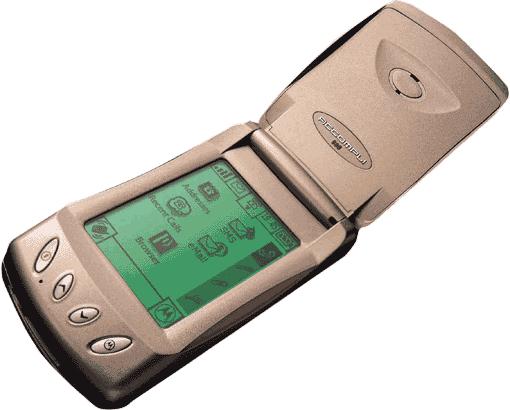
A year later, the first BlackBerry came on the market, in the form of the BlackBerry 7230. With its full-QWERTY keyboard and push email, it revolutionised office workers’ lives (although not necessarily for the better!) For years, though, it remained resolutely a business phone.
The hit phone of the era
The hit phone of this period was the Ericsson T68. Released in 2001, it heralded a revolution in phone features. Not only did it have a 256 colour display, it also came with animated wallpapers, themes, InfraRed, and even Bluetooth!
The T68 was so successful because these were features that other phones weren’t offering at the time. Sure, some phones offered some of the features, but no phone offered them all.
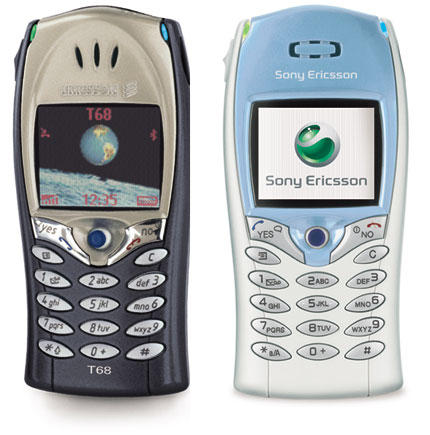
Its success soon led to an arms race, though, with more and more features quickly being bolted on. This culminated in the next stage of the mobile phone arms race – the rise of the feature phone.
2004 – 2006: the rise of the feature phones
From 2004, phone features shifted up a gear. Camera phones steadily increased in quality and megapixels, with the first 1 megapixel camera phones finally offering pictures that could be printed out (or at least viewed on the Web), rather than just displayed on the phone’s tiny screen.
In Japan, DoCoMo launched the first range of 1 megapixel camera phones (including the Sony Ericsson SO505i) in April 2003. The UK had to wait until March 2004 when Sharp launched the Sharp GX30, while the US got their first megapixeller (the AudioVox PM-8920) in April 2004.
I bought one of the first 1.3 megapixel camera phones that landed in the UK in 2004, in the form of the Sony Ericsson S700i (below). The phone had an odd horizontal swivel form factor, crude MP3 player and a 256,000 colour TFT screen.
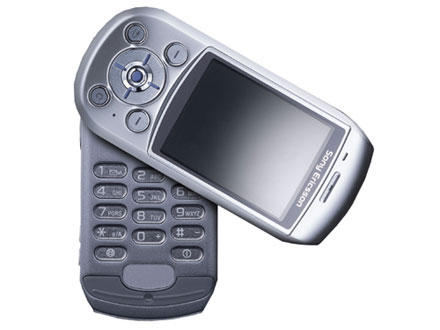
At the time, it was a stunning piece of technology – small, beautifully made, with a large screen and a real presence, at least compared to others phones of the day.
I’ve still got it today – it’s still working, having never gone wrong even once. Only now it’s used as my alarm clock!! Still, better than it going to Mazuma hell I guess!
The phones of the mid-2000s
Nokia’s N-Series
The mid-2000s saw the start of the unstoppable rise of Nokia, which announced the first N-Series phone, the Nokia N70, on April 27th 2005. Released in September 2005, the N70 laid the gauntlet down for other manufacturers, with a mouth-watering range of phone features, each of which proved to be of very high quality.
Whereas other manufacturers, such as LG, were piling on many features that were of a dubious quality, the features of Nokia’s N-Series phones were all a cut above. For example, the N70 featured a camera with a Carl Zeiss lens no less, and with not just one but two megapixels, as well as 3G and an MP3 playe. The arms race had well and truly begun.
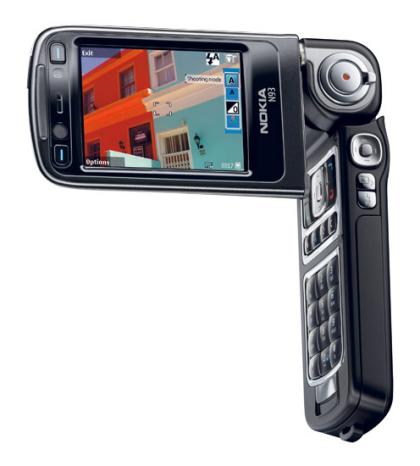
By the end of 2006, Nokia had announced the Nokia N93 (above) with a whopping 3.2 megapixels, 30fps video recording, and a form factor only its mother could like! It even came with WiFi built-in, which was lucky, as mobile data tariffs were absurdly expensive.
The first Sony Ericsson CyberShot and Walkman phones
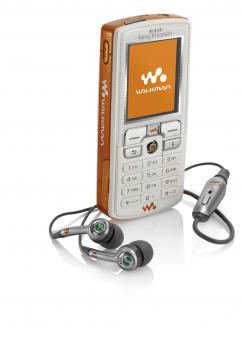
Sony Ericsson weren’t going to let Nokia take all the glory, though. They fired back with their first CyberShot and Walkman phones, the Sony Ericsson K800i and W800i (left) respectively.
The K800i, announced on February 28th 2006, didn’t just offer the same number of megapixels as Nokia’s N73 – it came with Sony’s legendary CyberShot technology, guaranteeing excellent picture quality.
Equally, the W800i promised legendary Sony Walkman sound quality and was a huge success, eating into the sales of MP3 players, which at the time looked doomed.
Of course, MP3 players weren’t doomed – they just adapted. But with mobile phones providing similar music experiences, they were threatening the very existence of the MP3 player as an independent device.
Smartphones getting smarter
Smartphones too were getting smarter. Sony Ericsson arguably led the field with its P range of smartphones – the P900, which launched in 2004 with a 65,000 colour TFT screen and handwriting recognition, was swiftly followed by the P910 and P990 (below), which came with a 256,000 colour screen, WiFi, 3G, video camera, and 2 megapixel camera.
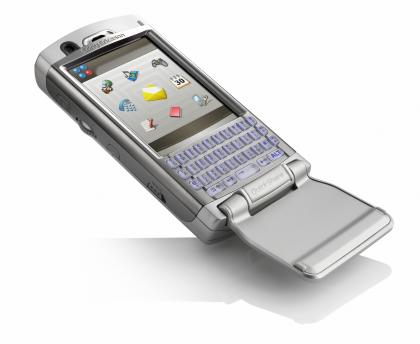
Smartphones were slowly getting the features of the feature phones (as it were!) – but still the feature phones, exemplified by Nokia, were the Kings of the hill.
The hit phone of the era
Having waffled on about feature phones being the stars of the show, the hit phone of the mid-2000s was the Motorola RAZR (below) – which wasn’t exactly bursting with features! Despite 1 megapixel camera phones becoming popular, Motorola fitted the early RAZRs with a useless VGA camera, with just 0.3 megapixels.
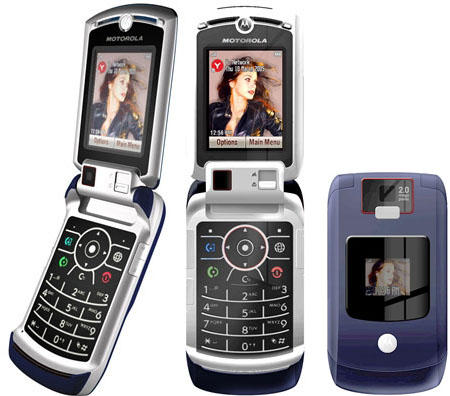
What it did offer though was style – in fact it oozed style from every pore, and was the best selling phone of the mid-Noughties by far, selling over 110 million units.
The RAZR was so successful, it even spawned its own niche of mobile phones – the designer phone (or fashion phone), with the likes of the LG Chocolate and Shine all desperate to outdo it in terms of thinness and looks.
For a few years, the RAZR reigned supreme, driving Motorola’s sales to record heights. It couldn’t last, though. Soon everyone had a RAZR, the phone became passe, it couldn’t compete on features, and Motorola couldn’t innovate.
As the RAZR’s popularity declined, so too did Motorola’s fortunes.
The next stage of the phone wars was at hand – and what was to become the single most important year of the decade for mobile phones.
The greatest moment in Mobile Phone history
The mid-noughties also saw the greatest moment in mobile phone history – the launch of MobileMentalism :) My first post was published on August 19th 2005, when I was recovering from ChickenPox, of all things!
Looking back on that first post, I was raving about the Nokia N91 that had just been announced, which came with a 4GB hard disk.
A hard disk in a phone?! Yesterday I bought a 32GB SD card that I can barely see, yet Nokia had to put a hard disk into their phone to get 4GB of storage just four years ago! Is it me, or is Moore’s law speeding up?!
2007: The single most important year of the decade
2007 deserves an entry all to itself, as it was a pivotal year in mobile phone history.
The feature phone was at its height, with phones offering every feature from every electronic gizmo on the market. Camera phones had reached 5 megapixels, WiFi was being increasingly used, mobile TV was briefly touted as being the feature of the future, and HSDPA had arrived, offering broadband speeds of up to 3.2Mbps on mobile phones for the first time.
But then, in March 2007, one phone finally arrived that knocked all others for six: the Nokia N95.
The Nokia N95 – the greatest feature phone of all
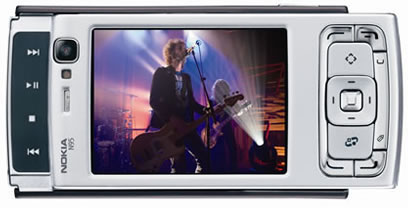
The N95 was a stunning piece of technology that included every feature conceivable, and some that even seemed inconceivable!
It contained class-leading features, such as a 5 megapixel camera that put other dedicated camera phones to shame, 30fps video recording, WiFi, HSDPA and a glorious 16 million colour screen.
Perhaps its greatest feature, though, was a built-in GPS device, which, with its built-in Nokia Maps software, turned the mobile phone into a personal Sat-Nav for the first time.
The N95 was a breakthrough in mobile phone engineering, and would serve to be the benchmark by which all other feature phones would be judged.
The Mobile Web
With the advent of HSDPA and faster processors, the mobile Web was finally within reach. I bought a Nokia E90 in late 2007, which had a large QWERTY keyboard, much of the same features as the N95 (GPS, video recording, WiFi, HSPDA and 3.2 megapixel camera), and, crucially, a wide 800 pixel display that was perfect for viewing Web pages (below).
Arguably, the E90 was the first mobile phone to enable desktop-like Web browsing on a mobile phone. There was just one small problem – somebody else was about to spoil Nokia’s party.
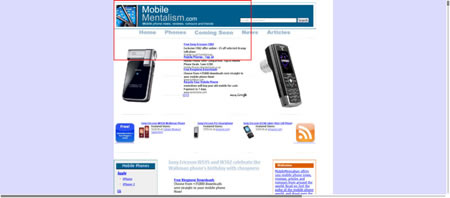
The iPhone changes everything
In June 2007, Apple released the iPhone. Just as Nokia were glorying in the technological achievements of the N95, Apple came along and made it look like a dinosaur at a stroke.
Although hamstrung with no 3G, and without many of the features of the N95, it marked a sea-change in people’s perceptions of what a mobile phone should be.
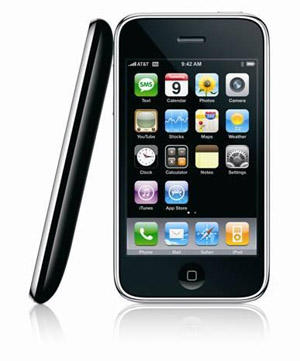
The iPhone offered an unparalleled user experience that to this day hasn’t been bettered. Today, no phone worth its salt comes without a touchscreen interface, while every manufacturer has had to go back to the drawing board and redesign its user interface.
Some, such as Sony Ericsson, have given up and used other companies’ operating systems, such as Google’s Android, as their own has simply not kept pace with the innovations that the iPhone brought to the table.
With its stunning user experience and unrivalled usability, the iPhone killed the feature phone at a stroke, and made the user experience and integration with the mobile Web the cornerstone of what mobile phones would be all about at the end of the Noughties.
2007, then, was both the defining year of the feature phone, and the end of the feature phone as we knew it. It’s no exageration to call it the single most important year of the decade for mobile phones.
2008 – 2009: the age of the Touchscreen phones
And so, to the end of the Noughties, a period when the words “iPhone killer” came attached to every new phone with a touchscreen interface. None were, of course, but we are at last seeing some real competition.
The iPhone saw off the feature phones. They still exist, of course – witness the popularity of the Sony Ericsson Satio and Samsung Pixon 12, with their superb 12 megapixel cameras. Equally, most phones these days have GPS and video, HSDPA and WiFi. Even Nokia’s lowest-specced N-Series phones offer more than the N95 did just three years ago.
But when every phone has the same features, they’re no longer features – they’re just a shopping list of specs that you expect a phone to have.
Today, the phones are all about the user experience. Not just the touchscreen, which again is an expected feature, but the user interface. How easy is the phone to use, how flash is its interface, how good is its Web browsing experience, and in particular, how tightly connected is it to a user’s social network?
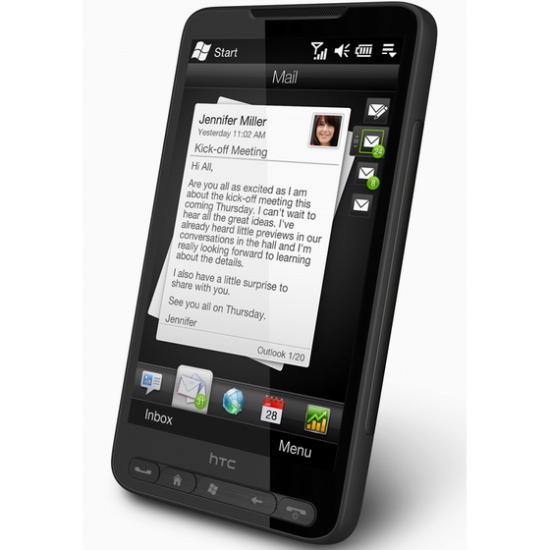
Facebook phones, Twitter apps, even Spotify on your phone – the features of the phone matter less and less as the mobile Web comes pouring into the device we put in our pocket.
Today’s phones have to offer all this against competition that’s stiffer than ever before, with new players, new technologies, and a whole new Web-based world that offeres a whole set of fresh challenges that hardware-based companies, such as Nokia and Sony Ericsson, are not used to dealing with.
There’s an app for that
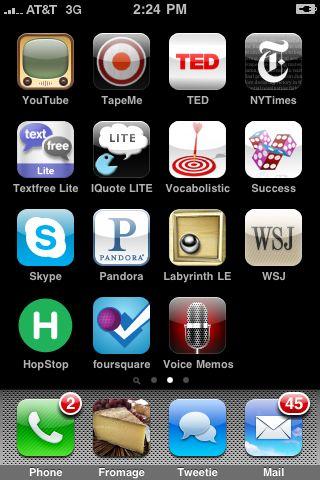
Thanks to Apple’s ads, the term ‘app’ has now become ubiquitous. Because of this, people getwhat apps and smartphones are all about. If a phone can’t be extended with a new app, consumers simply don’t want to know about it.

Apps have provided a rich new flexibility to phones that simply didn’t exist before. People can now communicate with each other, with their social networks, even with companies and with strangers in ways that the phone manufacturers could never have conceived.
The phone is no longer a black box that has a set number of features – it’s possibilities grow with each new app that’s added.
Of course, you can’t have an app unless there’s a place to download it. which has led to an explosion of competing app stores on the market, each serving a different mobile phone manufacturer. Currently, the iPhone and Android’s app stores are taking the lead in this field, and are expected to do so throughout the early part of the next decade.
With so many different app stores available, though, the market is becoming fragmented. Consmuers like choice, but not too much – app stores that are late to the party will become increasingly bare as developers focus on the clear leaders.
Android – another Barbarian at the gates

The end of the Noughties has seen the rise of new entrants. Not just Apple, but Google, with its increasingly popular Android platform.
Android phones such as the HTC Hero and Motorola Droid, have provided real challenges to the iPhone, offering smart new user interfaces based on an open platform that offers full customization.
HTC, the smartphone company that previously specialized in Windows Mobile devices, has also been on the ascendant, riding on the coat tails of Android’s success with a range of Android-based smartphones.
Palm comes back from the dead
After a wobbly few years, Palm, one of the early smartphone makers, threw a final throw of the dice and released a superb new touchscreen smartphone, the Palm Pre (below), which has superb user interface it makes previous Palms look like calculators.
The problem is, Palm’s a small company, and the Palm Pre is simply yet another glorious looking touchscreen smartphone, lost in a sea of other glorious touchscreen smartphones.
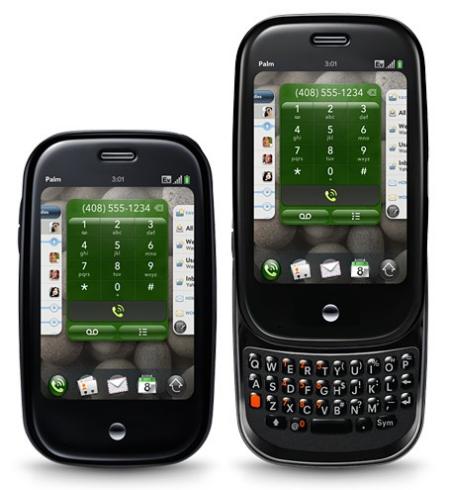
I hope they stay the course in the next decade, but rumours have already circulated that Palm are prime takeover targets, with Nokia the front runners. Personally, I don’t expect either Palm or BlackBerry to still be around by the end of the next decade, but Palm in particular are showing that they’re up for the fight!
Windows Mobile and Symbian, casualties of war
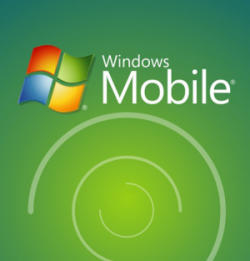
The new user experience provided by the iPhone and Android, and increasingly demanded by consumers, has left the old players in disarray, flat-footed as they find their software no match for the new pretenders.
Windows Mobile is on its last legs. Its current incarnation, Windows Mobile 6.5, is no match for the iPhone or Android, and requires manufacturers to write their own user interface on top of it to make up for its shortcomings.
Windows Mobile 7 will be released in 2010, but unless it offers a quantum leap above Android, it will be too little too late. Android is free; Windows Mobile isn’t. If Windows Mobile 7.0 can’t offer anything more than Android already does, then it’s finished.
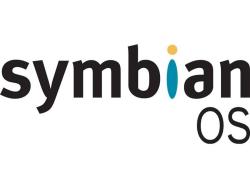
Nokia’s Symbian is also experiencing tough times. It was always a notoriously difficult platform to develop on, but with the market switching away from hardware towards the user experience, that’s the very last thing that a platform needs to be.
Nokia have a confusing strategy of now supporting two very different platforms, with some of their smartphones, such as the N97, running Symbian, while others, such as the Nokia N900 (below), running Maemo.
A new version of Maemo will be released in 2010; whether this will get Nokia’s full backing with a range of devices, or whether the company will stubbornly stick to its guns with Symbian, remains to be seen, but time is certainly not on its side.
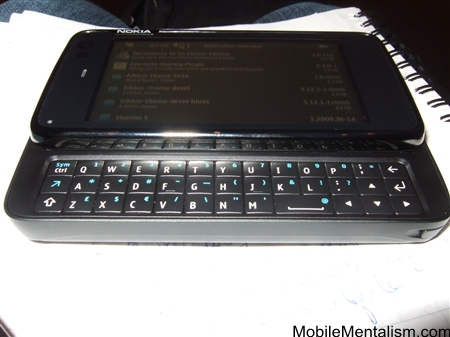
If there’s one thing the Noughties should have taught mobile phone manufacturers, it’s that lack of innovation is absolutely lethal.
The shifting fortunes of the big five mobile phone manufacturers
The figure below shows the changes in market share (expressed as a percentage) of each of the big five mobile phone manufacturers throughout the Noughties (Nokia is the top blue line). Perhaps the most shocking is the fate of Motorola. During its hey-day of the RAZR, it’s seen its market share plunge from 21.1% to just 4.5% of the global mobile phone market.
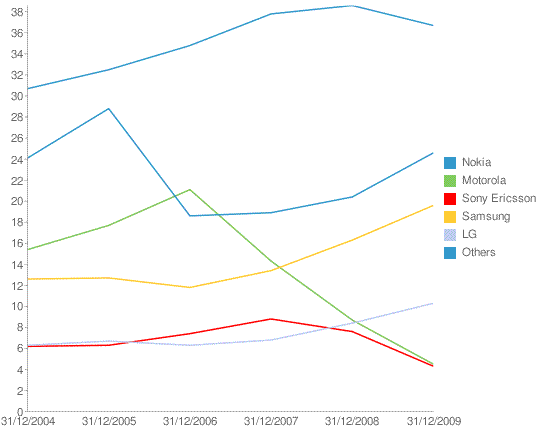
Just as Motorola missed the feature phone fad, so too were Sony Ericsson hit, as they released too many CyberShot and Walkman phones that didn’t offer enough innovation. The Satio and Aino have stemmed the plunge in market share for a while, but Sony Ericsson have real problems with the speed at which they innovate.
If you don’t innovate in mobile phones, you don’t stand still, you fall behind, as Motorola’s collapse showed. Sony Ericsson very nearly did the same thing, and aren’t quite out of the water yet. It simply takes them too long to release their phones, making them slow to meet market demand.
And now, as we conclude the Noughties, it seems that Nokia too are wobbling. Already Samsung may have overtaken them in the UK as the number one mobile phone manufacturer.
In 2010, Samsung will be focusing solely on smartphones, with its new Bada smartphone platform (below), plus other smartphones based on Windows Mobile and Android. The Korean company are showing that they can respond quickly to what the market wants. Feature phones are out – smartphones are in. Samsung have responded to this magnificently, while Nokia seem confused and therefore possibly vulnerable.
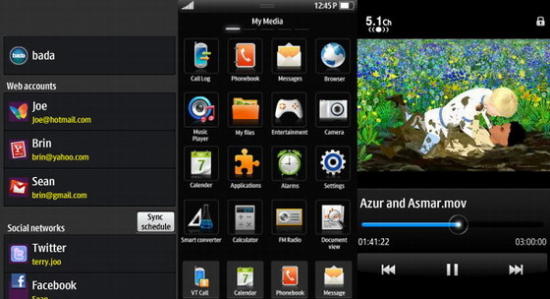
Adding to the pressure is Google, which is whipping up hype for its Android platform via its new Android-based Nexus One, which will be announced on January 5th.
The pace of innovation and the ferocity of competition in the mobile phone world has never been so strong. The Noughties have been a fantastic time for mobile phone fans, but we truly haven’t seen anything yet!
As we say goodbye to a decade of undreamed of features, and usher in a new decade of usability, touchscreens, mobile Web, social networking and undreamed of download speeds, the future’s not just bright – it’s not even Orange – the future is finally here!
A final note – the best selling phone of the decade
Finally, after all the innovation, the challenges, the superb engineering and the technological miracles that the Noughties gave us, what was the best selling mobile phone of the decade?
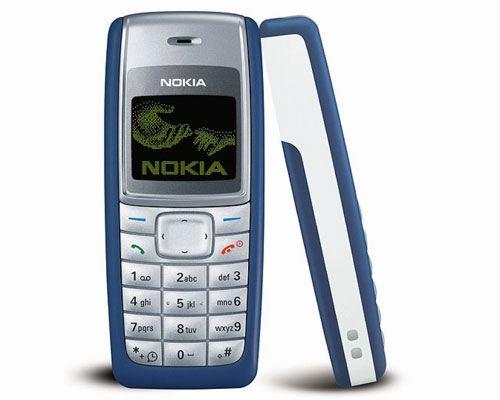
Would you believe, the humble Nokia 1100. With just a 95×65 black and white screen, no features of any form other than the game Snake, this humble phone managed to shift over 200 million units.
Who needs innovation?! Happy New Year :)


